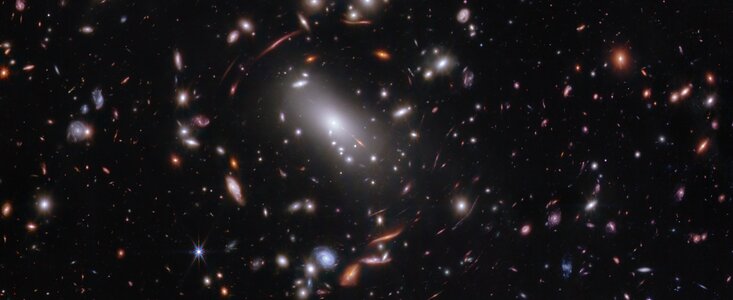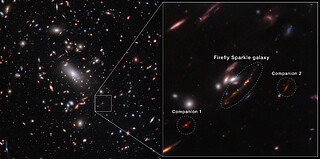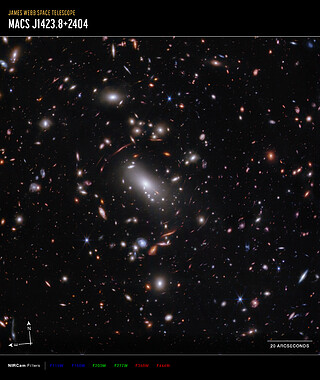weic2429 — Science Release
Found: first actively forming galaxy as lightweight as young Milky Way
11 December 2024
For the first time, the NASA/ESA/CSA James Webb Space Telescope has detected and ‘weighed’ a galaxy that not only existed around 600 million years after the Big Bang, but also has a mass that is similar to what our Milky Way galaxy’s mass might have been at the same stage of development. Other galaxies Webb has detected at this period in the history of the Universe are significantly more massive. Nicknamed the Firefly Sparkle, this galaxy is gleaming with star clusters — 10 in all — each of which researchers examined in great detail.
“I didn’t think it would be possible to resolve a galaxy that existed so early in the Universe into so many distinct components, let alone find that its mass is similar to our own galaxy’s when it was in the process of forming,” said Lamiya Mowla, co-lead author of the paper and an assistant professor at Wellesley College in Massachusetts. “There is so much going on inside this tiny galaxy, including so many different phases of star formation.”
Webb was able to image the galaxy in sufficient detail for two reasons. One is a benefit of the cosmos: a massive foreground galaxy cluster radically enhanced the distant galaxy’s appearance through a natural effect known as gravitational lensing. And when combined with the telescope’s specialisation in high-resolution imaging of infrared light, Webb delivered unprecedented new data about the galaxy’s contents.
“Without the benefit of this gravitational lens, we would not be able to resolve this galaxy,” said Kartheik Iyer, co-lead author and NASA Hubble Fellow at Columbia University in New York. “We knew to expect it based on current physics, but it’s surprising that we actually saw it.”
Mowla, who spotted the galaxy in Webb’s image, was drawn to its gleaming star clusters, because objects that sparkle typically indicate they are extremely clumpy and complicated. Since the galaxy looks like a ‘sparkle’ or swarm of fireflies on a warm summer night, they named it the Firefly Sparkle galaxy.
Reconstructing the galaxy’s appearance
The research team modelled what the galaxy might have looked like if its image weren’t stretched by gravitational lensing and discovered that it resembled an elongated raindrop. Suspended within it are two star clusters toward the top and eight toward the bottom. “Our reconstruction shows that clumps of actively forming stars are surrounded by diffuse light from other unresolved stars,” said Iyer. “This galaxy is literally in the process of assembling.”
Webb’s data show the Firefly Sparkle galaxy is on the smaller side, falling into the category of a low-mass galaxy. Billions of years will pass before it builds its full heft and a distinct shape. “Most of the other galaxies Webb has shown us aren’t magnified or stretched, and we are not able to see their ‘building blocks’ separately. With Firefly Sparkle, we are witnessing a galaxy being assembled brick by brick,” Mowla said.
Stretched out and shining, ready for close analysis
Since the image of the galaxy is warped into a long arc, the researchers easily picked out 10 distinct star clusters, which are emitting the bulk of the galaxy’s light. They are represented here in shades of pink, purple, and blue. Those colours in Webb’s images and its supporting spectra confirmed that star formation didn’t happen all at once in this galaxy, but was staggered in time.
“This galaxy has a diverse population of star clusters, and it is remarkable that we can see them separately at such an early age of the Universe,” said Chris Willott of the National Research Council Canada, a co-author and the observation programme’s principal investigator. “Each clump of stars is undergoing a different phase of formation or evolution.”
The galaxy’s projected shape shows that its stars haven’t settled into a central bulge or a thin, flattened disc, another piece of evidence that the galaxy is still forming.
‘Glowing’ companions
Researchers can’t predict how this disorganised galaxy will build up and take shape over billions of years, but there are two galaxies that the team confirmed are ‘hanging out’ within a tight perimeter and may influence how it builds mass over billions of years.
Firefly Sparkle is only 6500 light-years away from its first companion, and its second companion is separated by 42 000 light-years. For context, the fully formed Milky Way is about 100 000 light-years across — all three would fit inside it. Not only are its companions very close, the researchers also think that they are orbiting one another.
Each time one galaxy passes another, gas condenses and cools, allowing new stars to form in clumps, adding to the galaxies’ masses. “It has long been predicted that galaxies in the early Universe form through successive interactions and mergers with other tinier galaxies,” said Yoshihisa Asada, a co-author and doctoral student at Kyoto University in Japan. “We might be witnessing this process in action.”
“This is just the first of many such galaxies JWST will discover, as we are only starting to use these cosmic microscopes”, added team member Maruša Bradač of the University of Ljubljana in Slovenia. “Just like microscopes let us see pollen grains from plants, the incredible resolution of Webb and the magnifying power of gravitational lensing let us see the small pieces inside galaxies. Our team is now analysing all early galaxies, and the results are all pointing in the same direction: we have yet to learn much more about how those early galaxies formed.”
The team’s research relied on data from Webb’s CAnadian NIRISS Unbiased Cluster Survey, which include near-infrared images from NIRCam (Near-InfraRed Camera) and spectra from the microshutter array aboard NIRSpec (Near-Infrared Spectrograph). The CANUCS data intentionally covered a field that NASA’s Hubble Space Telescope imaged as part of its Cluster Lensing And Supernova survey with Hubble programme.
This work was published on 12 December 2024 in the journal Nature.
More information
Webb is the largest, most powerful telescope ever launched into space. Under an international collaboration agreement, ESA provided the telescope’s launch service, using the Ariane 5 launch vehicle. Working with partners, ESA was responsible for the development and qualification of Ariane 5 adaptations for the Webb mission and for the procurement of the launch service by Arianespace. ESA also provided the workhorse spectrograph NIRSpec and 50% of the mid-infrared instrument MIRI, which was designed and built by a consortium of nationally funded European Institutes (The MIRI European Consortium) in partnership with JPL and the University of Arizona.
Webb is an international partnership between NASA, ESA and the Canadian Space Agency (CSA).
Image Credit: NASA, ESA, CSA, STScI, C. Willott (NRC-Canada), L. Mowla (Wellesley College), K. Iyer (Columbia)
Links
Contacts
Bethany Downer
ESA/Webb Chief Science Communications Officer
Email: [email protected]
Ninja Menning
ESA Newsroom and Media Relations Office
Email: [email protected]
About the Release
| Release No.: | weic2429 | |
|---|---|---|






